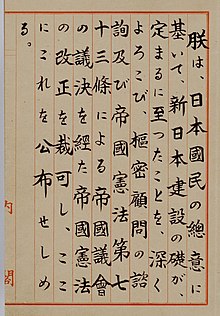Ji̍t-pún-kok Hiàn-hoat
Ji̍t-pún-kok Hiàn-hoat (日本國憲法) sī Ji̍t-pún ê hiān-hêng hiàn-hoat, mā hō-chò Chiàn-āu Hiàn-hoat (戰後憲法), Hô-pêng Hiàn-hoat (和平憲法), Chiau-hô Hiàn-hoat (昭和憲法), tī 1946 nî 11 goe̍h 3 hō kong-pò͘, 1947 nî 5 goe̍h 3 hō khí si-hêng. Che sī Ji̍t-pún-kok Chèng-hú tī 1945 nî tâu-hâng liáu-āu chè-tēng lâi chhú-tāi Tāi Ji̍t-pún Tè-kok Hiàn-hoat ê sin hiàn-hoat.
| Ji̍t-pún-kok hiàn-hoat | |
|---|---|
 Ji̍t-pún-kok Hiàn-hoat sū-giân | |
| Overview | |
| Original title | 日本国憲法 |
| Jurisdiction | Japan |
| Date effective | 3 May 1947 |
| System | Unitary parliamentary de facto[1] constitutional monarchy |
| Government structure | |
| Branches | Three |
| Head of state | Not defined in constitution.[2] The Emperor is "the symbol of the State and of the unity of the people", but carries many functions of a head of state.[1] |
| Chambers | Bicameral (National Diet: House of Representatives, House of Councillors) |
| Executive | Cabinet, led by a Prime Minister |
| Judiciary | Supreme Court |
| Federalism | Unitary |
| Electoral college | No |
| History | |
| First legislature | 20 April 1947 (HC) 25 April 1947 (HR) |
| First executive | 24 May 1947 |
| First court | 4 August 1947 |
| Amendments | 0[3] |
| Location | National Archives of Japan |
| Author(s) | Allied GHQ and members of the Imperial Diet |
| Signatories | Emperor Shōwa |
| Supersedes | Meiji Constitution |
| Full text | |
Tsù-kái
🔥 Top keywords: Thâu-ia̍hCarles PuigdemontMarie AntoinetteWikipediaWikipedia:Siā-lí mn̂g-chhùi-kháuPang-chān:Bo̍k-lio̍kTek-pia̍t:尋討Tē-jī-chhù Sè-kài Tāi-chiànPortal:Sin-bûn sū-kiāⁿWikipedia:Hoan-gêng sin iōng-chiáLūi-pia̍t:Choân-pō͘ phí-á-kiáⁿ bûn-chiuⁿWordPressWikipedia:Chhiū-á-khaWikipedia:Bián-chek seng-bêngWikipedia:Chiūⁿ-bāngEdgeworth (Pennsylvania)Wikipedia:It-poaⁿ ê seng-bêngKitagawa KeikoLating jī-bióWikipedia:Tāi-sài-koánIōng-chiá thó-lūn:Ndgf741Sin-bûn sū-kiāⁿDigital Monster6Eng-gíTek-pia̍t:最近其改變Bân-lâm-gúQR BéTek-pia̍t:我其貢獻Tōa hun-koah ko chè-liōng tiâu-kiông hòng-siā tī-liâuÌn-tō͘Bí-kokSò͘-ūi Mi̍h-kiāⁿ Sek-pia̍t-hōPang-bô͘:Cite webSHA-2TomorAzumanga DaiohISO 8601tóng-àn:Nalvadi Krishnaraja Wodeyar 1881-1940.jpg